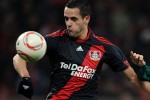 On a night that England struggled to a home draw with Ukraine, one glaring issue was Roy Hodgson’s readiness to use their inexperienced, and unready, youth.
On a night that England struggled to a home draw with Ukraine, one glaring issue was Roy Hodgson’s readiness to use their inexperienced, and unready, youth.
A one off poor performance? The game that revealed England’s next ‘big thing’ to be just another ‘could’ve been’? Or, an example of an inherent English problem?? Tom Cleverley’s disappointing performance did not only highlight how undeveloped he looked, but also highlighted the disparaging distance between the future stars of England and the ‘Golden Generation’.
Firstly, it cannot be ignored how poorly Cleverley performed. Frequently touted as the answer to England’s midfield problems, Cleverley is in the unfortunate position of filling the void of ageing stars Frank Lampard and Steven Gerrard, once they retire. However, Cleverley looked markedly off the pace; his touch, tactical awareness and tepid approach were glaringly obvious, and until he was substituted, looked completely out of his depth. This was highlighted best by his three attempts at goal. The first two were clear goal scoring opportunities, but he lacked the poise and finesse expected, especially given his position as an attacking midfielder, someone who is needed to create and score goals.
Though unfortunate to hit the woodwork on his third attempt, Cleverley’s failure to convert any of these chances was worrying for someone playing in such a goal-necessary position. His performance was also highlighted by his lack of link-up play with Jermaine Defoe, as well as his failure to imprint himself on the game. Throughout the game he looked uncomfortable in his position, as well as almost in awe of the expectation upon him. Despite the fact that at 23 he is not as young as some players in the England squad, he is still a young and inexperienced international, with a huge amount of expectation upon him.
And herein lies the problem. England seem to have skipped a generation, cast off a lot of ‘maybe’s and ‘could’ve been’s, over relied on the Golden Generation and incorporated a significant number of younger players too early.
Alex Oxlade-Chamberlain, only 19, has already played 7 games, and seems to be cementing a place as a starter for both club and country. When Theo Walcott and Daniel Sturridge were struck with illness, both 23, Raheem Sterling (17), Ryan Bertrand (23) and Adam Lallana (24) were called up. With a combined total of only 57 youth caps between them, and only Bertrand holding any senior caps (two), this presents the problem England – an inability to graduate young players through its youth system so that, come 23/24, they’re ready for senior international football.
Instead, many players are flung from U17/19/21 to the senior squad following a handful of good performances for their club. Sterling is a fine example of this; after Liverpool manager Brendan Rodgers requested Sterling to stay in the U17’s, and not be promoted to the U21, Roy Hodgson called him up to the senior squad, forgoing both the U19 and U21 squads. Though Hodgson did say Sterling would not get any playing time, it does exemplify an English trend – one of bi-passing youth ranks, direct entry into the senior squad, placing large burdens of expectation upon their shoulders (though this is in part down to the media) and burning them out before they reach their physical and technical peak.
Not only does it potentially harm players as individuals, it also has the prospective of collectively damaging England’s chances of success at international competitions. One reason for Spain’s success is often put down to its players continually playing together at various stages of the national set up, thus creating a homogenous team that has a greater understanding of one another. England, on the other hand, are at complete odds with this; over relying on a handful of players that are still (just about) young enough to play for England (Gerrard, Lampard, Ashley Cole, John Terry et al) whilst cherry picking the best of the players just about old enough. They are then forcefully integrated into the senior squad, and expect too much of such young players. Although they may have a group of gifted individuals, England has continuously failed to assemble a national team for the past three tournaments.
Though a number of factors obviously affect how teams are brought together (injuries, manager, club commitments, personal issues), it is no secret that England fails to allow its potential future to evolve together. Where the likes of Casillas, Ramos, Puyol, Xavi, Iniesta, Alonso and Torres all have a history of playing together during their primitive years, England forces gifted individuals in to a team and expects greatness. This is baffling to say the least as international managers get less time with their squad, so the constant changing of players creates an extremely unsettled, and unbalanced, side.
So, who is really to blame? Steven Gerrard and Frank Lampard have a combined total of 190 caps, yet the rest of England’s front 6 had a total of only 93 – the same number of caps Frank Lampard possesses individually – with Jermaine Defoe throwing 51 of those in to the pot.
So, is it really Tom Cleverley’s fault that he wasn’t ready to play for England?



